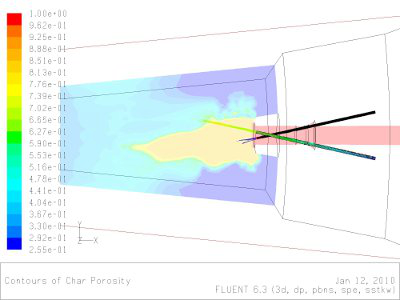RFCS-Inject
The objective of the project is the extension and development of raceway models for the use of different alternative reduction agents, e. g. plastic particles or heavy fuel oil. Different physical properties of the injected materials require the introduction of additional models (e.g. co-injection of gaseous, liquid, or solid reductants).
An improvement the Computational Fluid Dynamics (CFD) simulations using the previously developed models can be achieved by improving the quality of the boundary conditions and the material property data. The open source reaction kinetics code Cantera has been used to analyze the formation of radicals during the reactions within the raceway volume.
New code considering the evaporation, pyrolysis and oxidation of liquid injection materials has been implemented.
In addition to that future improvements of the simulation model have been discussed. Trial runs using the Euler Granular Multiphase (basing on the kinetic theory of granular flows to account for combined gas and solid flow) approach have been carried out to analyze the potential and problems. Also a basic code for the implementation of a dual grid approach for the solid phase and the gas phase with coupling terms for mass, momentum and energy has been prepared to evaluate this concept.
A CFD base case for the combined injection of plastic particles and heavy fuel oil droplets has been set up. Different nozzle geometries at the heavy fuel oil injection lance have been simulated. First simulation results of this model can be seen in the figure [co_injection.jpg]. The cold flow simulations using the Euler Granular approach compare well to the results of the developed model, similar raceway shapes could be achieved, the dual grid approach looks also very promising.

Figure 1: Simultaneous injection of particles (green-yellow – slow reaction) and fuel oil (dark blue – rapid evaporation) - background: shape of the raceway at injection level (yellow)
K1-Met
CFD methods have been used to simulate the injection of plastics into the blast furnace raceway at blast furnace A at voestalpine Stahl GmbH, Linz (Austria). Various auxiliary reducing agents like oil, tar, pulverized coal, natural gas, coke oven gas and waste plastics are applied for injection the blast furnace to decrease the coke rate.
For a better understanding of the effects of combined injection an extended model is being developed based on a CFD model for plastic particle injection developed in the working group. The code has been extended to handle the injection of multicomponent droplets like heavy fuel oil and tar. An important parameter to provide valid estimates of the oil spray length is the droplet size distribution of the fuel oil. Unfortunately for the injection lance geometry used at the modelled blast furnace no suitable correlations to predict the spray parameters like droplet size and droplet speed have been found.

Figure 2: Geometry of the lab scale model for the oil injection lance and the tuyere
Since direct measurements of the size distribution at raceway conditions are not possible a lab scale model based on similarity scaling rules (Reynolds analogy) has been developed (see also Figure 2). Optical measurements using particle image velocimetry (PIV), laser doppler anemometry (LDA) and a high speed camera have been carried out. Based on this experimental data a correlation for the spray parameters has been implemented into the CFD model.
Using these improved boundary and inlet conditions as well as improved physical properties the quality of the CFD simulation results and the predictions could be further improved. Also other material data like thermal conductivity and heat capacity of the coke bed will be measured to enhance the performance of the simulation model.


